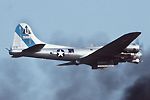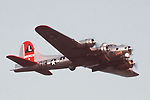
original at www.af.mil |
B-17 in flight
(U.S. Air Force photo by Staff Sgt. Angela Stafford)
This B-17, "Sentimental Journey," at the Wings of Eagles Air Show in Big Flats, NY, is from the Confederate Air Force Arizona Wing. Certainly one of the most dramatic symbols of U.S. air power during World War II, the B-17 Flying Fortress can occasionally be seen flying over the American countryside during airshows and training missions. At just over 100 feet and grossing more than 30 tons it was the largest aircraft of it's day. It first saw combat in the pacific at the end of a long ferry flight from California when they flew into the attack on Pearl Harbor Dec. 7, 1941. The first Amerian B-17 flew in Europe in 1942. They carried the war to the heart of Germany and were loved by their crews for bringing them home despite extensive battle damage. A bomber crews tour was 25 missions, one out of ten went down on every mission. One third of the total B-17 production of 12,731 went down during the war, and the Eigth and Fifteenth Air Forces' personnel losses totaled almost one hundred thousand men. Today there are only nine B-17s in flying condition. Several others are under restoration to fly or use on static display. |

original at www.af.mil |
"Tora, Tora, Tora!" - A B-17 recreates a bombing pass
(U.S. Air Force photo by Staff Sgt. Angela Stafford)
A B-17 Flying Fortress recreates a World War II bombing raid at the Wings of Eagles Air Show in Big Flats, NY. The B-17 is certainly one of the most dramatic symbols of U.S. air power during World War II, the first bombs dropped from American Aircraft during the war were from Fortresses. It first saw combat in the pacific at the end of a long ferry flight from California when they flew into the attack on Pearl Harbor Dec. 7, 1941. The first Amerian B-17 flew in Europe in 1942. They carried carried the war to the heart of Germany and were loved by their crews for bringing them home despite extensive battle damage. A bomber crews tour was 25 missions, one out of ten went down on every mission. One third of the total B-17 production of 12,731 went down during the war, and the Eigth and Fifteenth Air Forces' personnel losses totaled almost one hundred thousand men. Today there are only nine B-17s in flying condition. Several others are under restoration to fly or use on static display. |

original at www.af.mil |
Sentimental Journey B-17
(U.S. Air Force photo by Staff Sgt. Angela Stafford)
This B-17, "Sentimental Journey," at the Wings of Eagles Air Show in Big Flats, NY, is from the Confederate Air Force Arizona Wing. Certainly one of the most dramatic symbols of U.S. air power during World War II, the B-17 Flying Fortress can occasionally be seen flying over the American countryside during airshows and training missions. At just over 100 feet and grossing more than 30 tons it was the largest aircraft of it's day. It first saw combat in the pacific at the end of a long ferry flight from California when they flew into the attack on Pearl Harbor Dec. 7, 1941. The first Amerian B-17 flew in Europe in 1942. They carried the war to the heart of Germany and were loved by their crews for bringing them home despite extensive battle damage. A bomber crews tour was 25 missions, one out of ten went down on every mission. One third of the total B-17 production of 12,731 went down during the war, and the Eigth and Fifteenth Air Forces' personnel losses totaled almost one hundred thousand men. Today there are only nine B-17s in flying condition. Several others are under restoration to fly or use on static display. |

original at www.af.mil |
Bombs Away - A vintage B-17 performs
(U.S. Air Force photo by Staff Sgt. Angela Stafford)
This B-17 Flying Fortress named "Yankee," makes a flyby with the bomb doors open during an air show in Big Flats, NY. At just over 100 feet and grossing more than 30 tons it was the largest aircraft of it's day. The first bombs dropped by American aircraft in WW II were from the B-17. It first saw combat in the pacific at the end of a long ferry flight from California when they flew into the attack on Pearl Harbor Dec. 7, 1941. The first Amerian B-17 flew in Europe in 1942. They carried the war to the heart of Germany and were loved by their crews for bringing them home despite extensive battle damage. A bomber crews tour was 25 missions, one out of ten went down on every mission. One third of the total B-17 production of 12,731 went down during the war, and the Eigth and Fifteenth Air Forces' personnel losses totaled almost one hundred thousand men. |

original at www.af.mil |
B-17 "Yankee" Flying Fortress
(U.S. Air Force photo by Staff Sgt. Angela Stafford)
This B-17 Flying Fortress, named "Yankee", takes off during an air show in Big Flats, NY. At just over 100 feet and grossing more than 30 tons it was the largest aircraft of it's day. The first bombs dropped by American aircraft in WW II were from the B-17. It first saw combat in the pacific at the end of a long ferry flight from California when they flew into the attack on Pearl Harbor Dec. 7, 1941. The first Amerian B-17 flew in Europe in 1942. They carried the war to the heart of Germany and were loved by their crews for bringing them home despite extensive battle damage. A bomber crews tour was 25 missions, one out of ten went down on every mission. One third of the total B-17 production of 12,731 went down during the war, and the Eigth and Fifteenth Air Forces' personnel losses totaled almost one hundred thousand men. |

original at www.af.mil |
B-17 "Fuddy Duddy"
(U.S. Air Force photo by Staff Sgt Angela Stafford)
"Fuddy Duddy," at the Wings of Eagles Air Show in Big Flats, NY, is owned and operated by the National Warplane Museum in Elmira, NY, and is one of only nine B-17s still flying. Occasionally a B-17 Flying Fortress can be seen flying over the American countryside during airshows and training missions. At a recent 50th Anniversary Air Show in Big Flats, NY, several members of the original WW II Fuddy Duddy crew gathered to reminnice and share war stories. At just over 100 feet and grossing more than 30 tons it was the largest aircraft of it's day. It first saw combat in the pacific at the end of a long ferry flight from California when they flew into the attack on Pearl Harbor Dec. 7, 1941. The first Amerian B-17 flew in Europe in 1942. They carried the war to the heart of Germany and were loved by their crews for bringing them home despite extensive battle damage. A bomber crews tour was 25 missions, one out of ten went down on every mission. One third of the total B-17 production of 12,731 went down during the war, and the Eigth and Fifteenth Air Forces' personnel losses totaled almost one hundred thousand men. |

original at www.af.mil |
From B-17 to B-52: two pilots share bomber heritage with public
(U.S. Air Force Photo by Staff Sgt. Angela Stafford)
FREDERICK, Md. (AFPN) -- The B-17 bomber "Nine-O-Nine," piloted here by retired Col. Robert K Morgan and B-52 pilot Maj. John R. Bernier, can often be seen flying during air shows and training missions. This restored B-17 bomber belongs to the Collings Foundation of Stow, Mass. |
^^ TOP ^^
|

